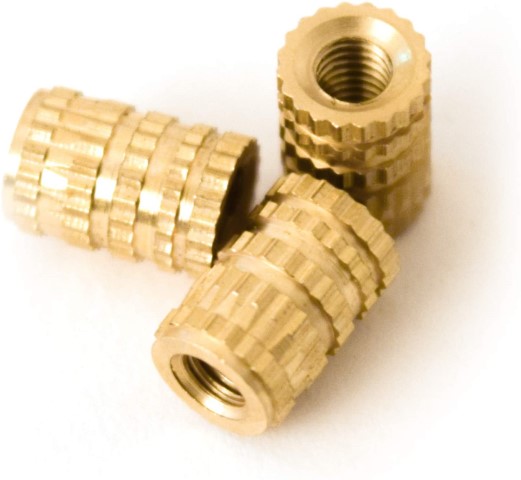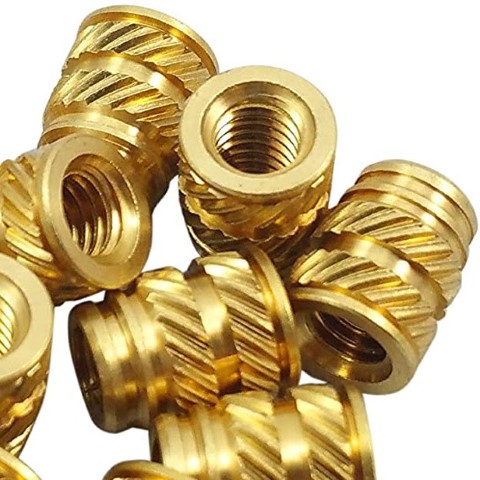 
     |
| ANyone have experience with heated thread inserts for plastic? (Page 1/1) |

|
sjmaye
|
MAY 04, 06:00 PM
|
|
I am working on my instrument cluster. There are several holes that are stripped out. I was considering using inserts that you heat up and press in to the plastic. Here is a video on it.
Do any of you have experience with these?
|
|

|
Fiero Ron
|
MAY 04, 07:39 PM
|
|
I have used them in 3D printing, I have only used the ones from Amazon but I have a set that I ordered from McMaster Carr that is better designed (haven’t tried them yet). The thing about the ones I got from Amazon is that they are the same outside diameter the whole way through (and you want the hole slightly undersized) so it was tough to keep them from falling while waiting for them to get heated up and pressed in. I have had good luck with just a hobby grade soldering iron and holding the insert until it melted in place. I would recommend the McMaster Carr ones because of their design and since they have a reduced diameter portion on the end, so that it is held in place and centered while you wait for the soldering iron to heat them up. This would make it easier to install without having the special attachment on the soldering iron as shown in the video. And for what you plan on using them for, it seems like it should work out for that as long as there is enough plastic on the outside diameter to structurally hold the inserts in place. And it takes quite a bit of overtightening to get them to spin out, and in an instrument cluster you wouldn’t be cranking down on them and it won’t see much stress compared to, for example, the screws holding the radio in place. Hope this helps.
Ron
|
|

|
sjmaye
|
MAY 05, 06:12 AM
|
|
Hi Ron,
Thanks for your reply. Not sure I understand the difference between the Amazon and McMaster inserts. See if I have it right below.
Insert with no step down

Insert with step down

Both photos are from Amazon. I could see that the step down would help align and enter the hole. Is this what you are talking about?
Why am I considering this? There are many spots around the car that the plastic threads are stripped or partially stripped. I want all the screws tight. Not stripped. Not partially stripped. It is a little thing, but I want everything to be tight going down the road. I have tried filling the holes with various materials, but they don't hold either.
These inserts seem like they would provide a very rigid connection point. Only problem I see is that I am a sticker with using all original screws. Especially where they can be seen. All the holes I have that are stripped have sheet metal type fasteners. If I use this inserts I would need to switch to some sort of machine screw. Do they may inserts for sheet metal screws?
Thought- I could drill out the stripped hole to a larger size. Epoxy in a plastic rod that would create stronger threads for the original screw.
|
|

|
Fiero Ron
|
MAY 05, 12:17 PM
|
|
That step-down in the second picture is what I was referring to. I guess I went with McMaster Carr and didn’t look into Amazon any further since I had an order I was making with them. The downside with these types of inserts I believe is that they are only for machine screws. I don’t think they have them for the fasteners that you plan on using them for since I believe they are designed to self-tap the plastic hole (and I am not sure if there is a standard for these screws like there is for machine screws). It seems like the you may have more luck trying your proposed method, and try to find a plastic-specific epoxy that will be somewhat flexible (to avoid cracking and snapping off) and that will hold the plastic rod in place (this sounds like a good idea). The hole should be slightly undersized and the threads should be formed by screwing in the fastener. I’m sure there are plenty of different ways to successfully repair this, but I haven’t attempted anything like this yet. Since you mentioned this, I’m sure I will be keeping an eye out for stripped screw holes when it’s time for me to reassemble the interior of my project car. Good luck and let us know how it goes.
Ron
|
|

|
theogre
|
MAY 05, 03:04 PM
|
|
Most are Not heat installed.
Many are Pressed in a Specific Size of Hole for a given material and may fail to hold even then in some types of material or other problems.
Some are sonic pressed for plastics. About same idea as sonic welding. Sonic heats but instant cools when turn off or tip is remove from parts.
Heat install by Soldering Iron etc on plastics often over melt the area and causes problems. Normal heat takes longer to heat and cool off keeping many plastics at melt point far longer then sonic heat.
Plus Many Car plastics are Theroset types are won't melt them return to normal. Others like Polypropylene are thermoform and cab melt to take a new shape.
I lost count of how many inserts have failed over time in plastic whatever made by big companies.
"Re-threaded" old plastic parts w/ inserts... Often the plastic isn't thick enough to accept them or has other problems to work long. Dash plastic frames are broken/cracked not just for abuse by users and hardware but 30+ years of Ozone and other pollution in a car. Worse if someone smokes.
------------------
Dr. Ian Malcolm: Yeah, but your scientists were so preoccupied with whether or not they could, they didn't stop to think if they should.
(Jurassic Park)
The Ogre's Fiero Cave[This message has been edited by theogre (edited 05-05-2020).]
|
|

|
Fiero Ron
|
MAY 05, 04:30 PM
|
|
That is very interesting Ogre, and I haven’t taken into account that it may be thermoset plastic. I’m glad to hear more input on this. My experience using the soldering iron has probably been pretty good since 3D printing is melting a plastic filament through an extruder, and re-melting it probably doesn’t affect it that much. I’m sure it changes some characteristics of the plastic, but what I’m doing with 3D printing is as a hobby. And I’ve heard how ozone can damage plastic, especially rubber. I’ve heard stories of shops storing wheels and tires in the same location as their air compressor, and since electric motors generate ozone, that is the worst location to store tires, they crack and dry rot.
Ron
|
|

|
sjmaye
|
MAY 05, 04:41 PM
|
|
|
Guess I am back to experimenting with epoxy and such. Can't stand loose screws.
|
|

|
sjmaye
|
MAY 05, 04:52 PM
|
|
|
Can someone tell me with assurance what is the screw size and pitch of the screws holding the instrument cluster bezel on? It measure 4mm nominal. Something like 0.9mm thread pitch. But my verniers are crummy. Don't trust them. This size screw is used frequently throughout the dash and console.
|
|

|
theogre
|
MAY 05, 06:01 PM
|
|
| quote | Originally posted by Fiero Ron:
That is very interesting Ogre, and I haven’t taken into account that it may be thermoset plastic. I’m glad to hear more input on this. My experience using the soldering iron has probably been pretty good since 3D printing is melting a plastic filament through an extruder, and re-melting it probably doesn’t affect it that much. I’m sure it changes some characteristics of the plastic, but what I’m doing with 3D printing is as a hobby. And I’ve heard how ozone can damage plastic, especially rubber. I’ve heard stories of shops storing wheels and tires in the same location as their air compressor, and since electric motors generate ozone, that is the worst location to store tires, they crack and dry rot. |
|
PLA and most others are thermoforms for hobby 3D.
Ground Level Ozone (Full name for EPA etc reasons) is cause by many things not just electric motors. With correct conditions spilled/leaked Gasoline and more make Ozone w/ help of UV light from Sun.
PA calls such "bad air days" as Code Orange includes Ozone on Hot days etc. because affects people w/ asthma and so on. Other states have different names for same.
UV also doesn't play well w/ many plastic types.
|
|

|
theogre
|
MAY 05, 06:35 PM
|
|
| quote | Originally posted by sjmaye:
Guess I am back to experimenting with epoxy and such. Can't stand loose screws. |
|
Many epoxies and other glues don't work well w/ some plastic types even so claim it works w/ plastics.
Most dash screws are self tapper and doesn't matter much on threads.
Thickness of inner "core" can matter because bigger "core" can break the plastic. Current screw core is likely tight as is and many plastics shrink a tiny bit depending on things both together doesn't help even before pollution etc make many types brittle or worse.
|
|
    
  |















